Desert Plant Walk at Usery Mountain Park
Learning about Sonoran desert plants in the Phoenix East Valley at Usery Mountain Park
Usery Mountain Regional Park is a 3,648-acre park set at the western end of the Goldfield Mountains in Phoenix Valley’s east side. The park is home to a variety of Lower Sonoran Desert plants and animals. When I set out to attend a morning event entitled “Desert Plants”, I expected a pleasant walk amid beautiful scenery. I didn’t know if I would learn anything new about desert plants beyond what I’d already picked up on other tours. But I did. The great diversity of plants which thrive in the harsh conditions of drought and heat in the Sonoran desert means there is always more to learn.
The hour long tour focused on how desert plants adapt to these harsh conditions. The very knowledgeable Range B encouraged questions of all kinds about the desert and, as a result, the scope of what we covered was broader than just the plants’ adaptive abilities. We even busted a few myths.
One of the myths to be busted was that you can survive if stranded in the desert by cutting into a cactus for water. Cacti do store water, but it is very acidic and can be toxic to humans. It may result in diarrhea and further dehydration. The prickly pear pads sold in grocery stores or found in Mexican restaurants are generally young pads which are less acidic. Also, cooking leaches out the acids.
The spines of the cacti serve a few purposes, one of which is protection from predators. However, some animals, such as javelinas and pack rats, have figured out how to nibble around the spines.
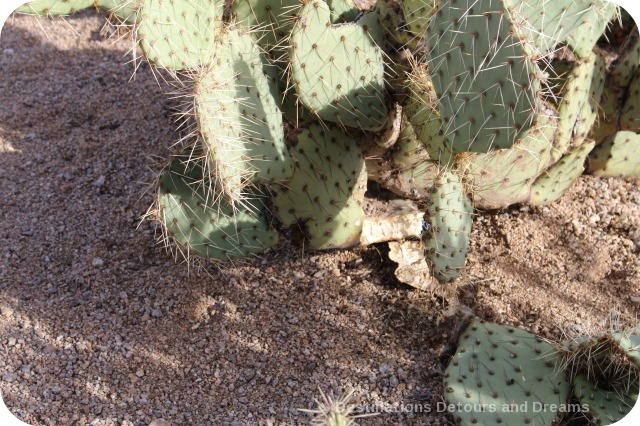
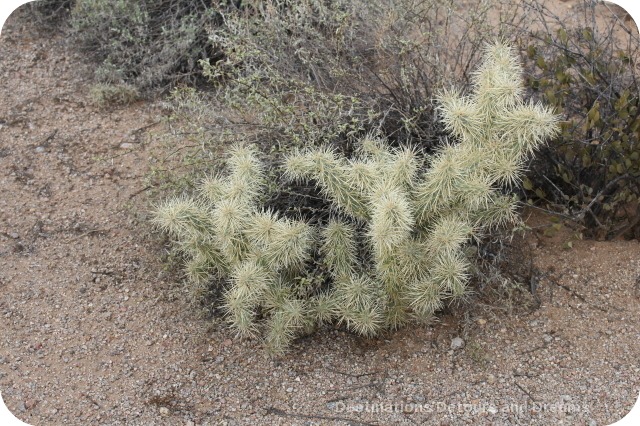
The spines help provide cacti with shade. And in some cases, as with certain varieties of cholla, they help with propagation. The barbs are sensitive to nearby movement and easily loosen from the rest of the plant to attach themselves to a passerby. When the detached segment later falls to the ground, it takes root and forms a new plant. The plants have been nicknamed “jumping cholla” because of the ease with which segments detach from the plant, but they don’t really jump.
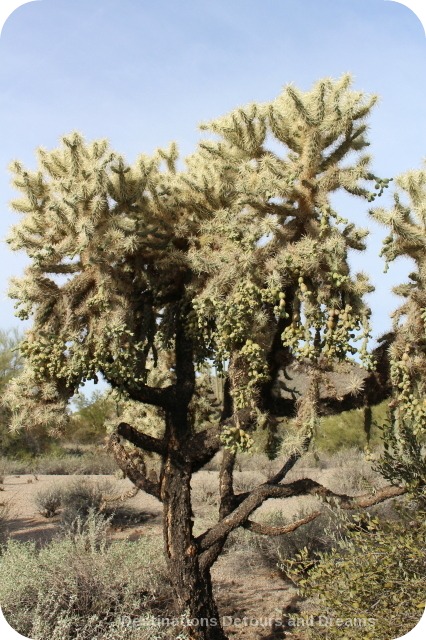
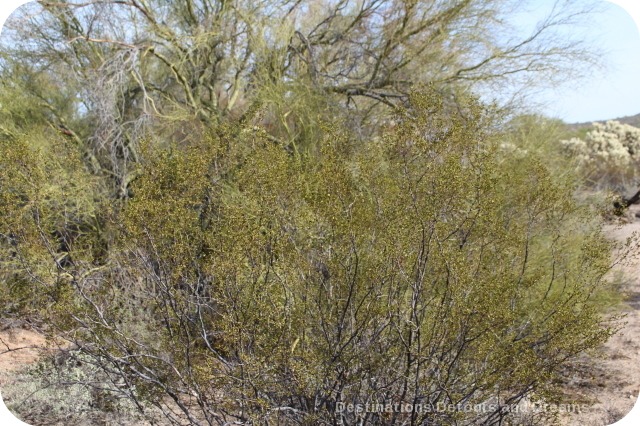
I was familiar with information Ranger B provided about the creosote bush. The bush gets its name for the smell it gives off, which is said to be like creosote. We were told to cup some leaves in our hands, blow directly on them three times, and then smell. The leaves give off a definite musky smell. It is known as the “smell of the desert”, because the smell permeates the valley during rains. The leaves are waxy, coated with a sticky resin which protects against ultraviolet rays, reduces water loss, and repels animals. The bush is covered with yellow flowers in spring time.
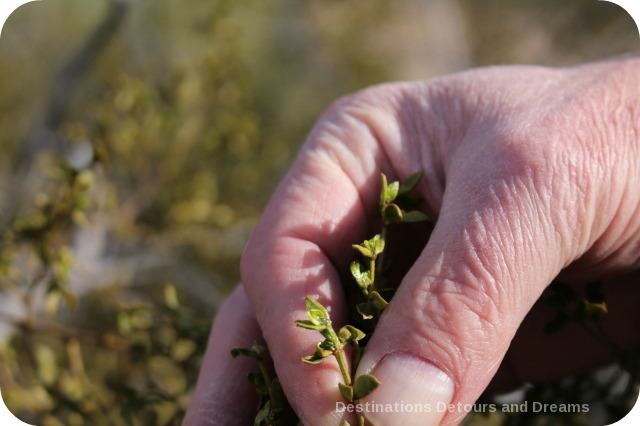
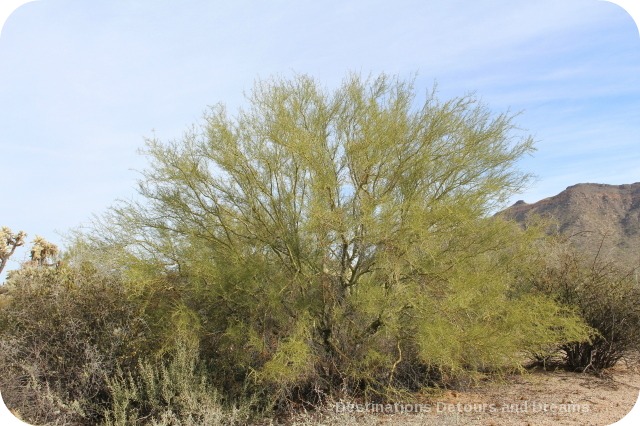
Some desert trees, such as the palo verde, are drought-deciduous, meaning they lose their leaves in the dry season to conserve water. Even when they are in bloom the leaves of the palo verde tree are thin so the trees loses less water through transpiration. Broad leaves capture sunlight to make food through photosynthesis. In the absence of broad leaves, the green bark on the palo verde tree has taken over much of the photosynthesis work.
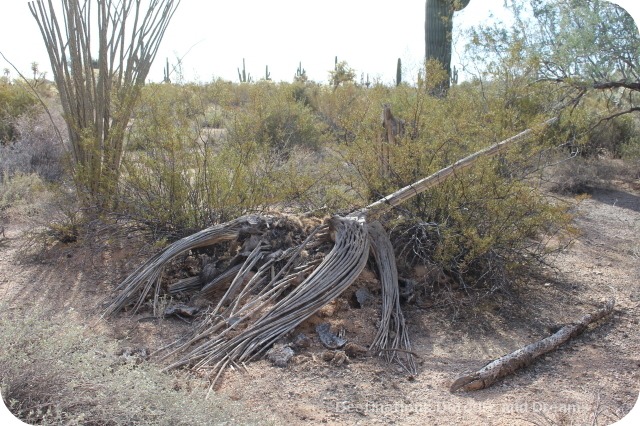
providing homes for desert creatures
One of the others on the tour asked Range B about fire. I grew up on the Canadian prairies. Although little of the natural tall grass prairie remains, I did know that fire was important to its rejuvenation. Fire is not needed for rejuvenation in the desert. The spaces between plants act as firebreaks helping plants survive fire. In many settled parts of the Valley, non-native plants have invaded that space. Spaces still exist in Usery Mountain Park. All plants in the park are native. No watering is done, except for the landscaped area immediately around the Nature Center building.
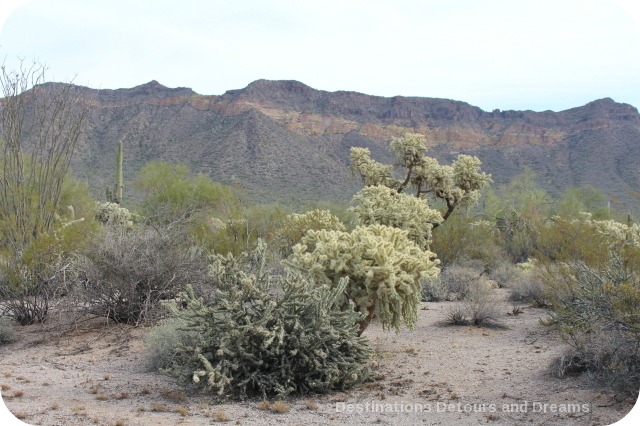
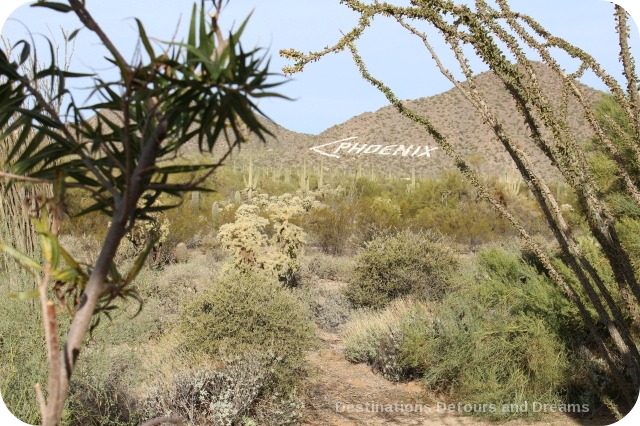
The Desert Plant Walk took place on the quarter-mile Desert Hawk trail behind the Nature Center just inside the park. Usery Mountain Regional Park has twenty trails of varying length and difficulty, for hiking, mountain biking, and horseback riding. There are camping facilities, day picnic areas, a couple of covered playgrounds, and an archery range.
The park hosts dozens of events each month, covering a variety of topics. A sample includes edible plants, moonlit walks, myth busting, all about bighorn sheep, and beginning desert hiking. The cost of the events is included in the park entrance fee. I enjoyed my Desert Plant Walk so much I hope to be able to get back and take in some of the other events.
If you enjoyed this post, sign up for Destinations Detours and Dreams monthly e-newsletter. Get behind the scenes information and sneak peeks ahead in addition to a recap of the month’s posts.
PIN IT
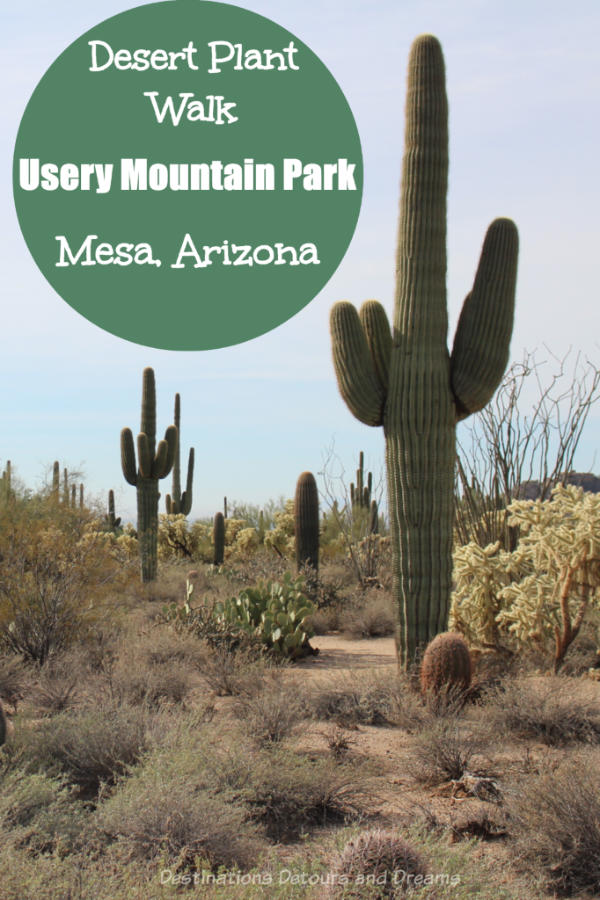

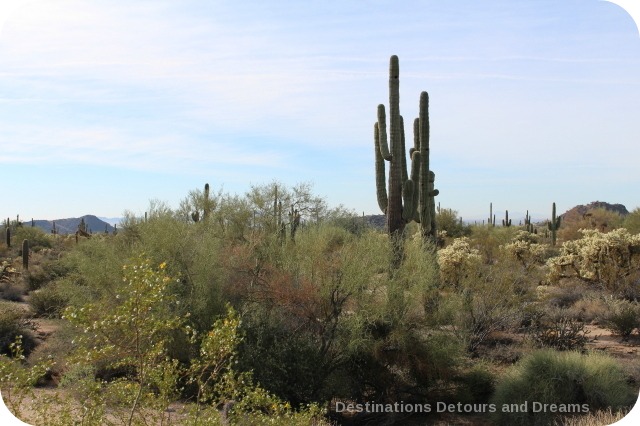
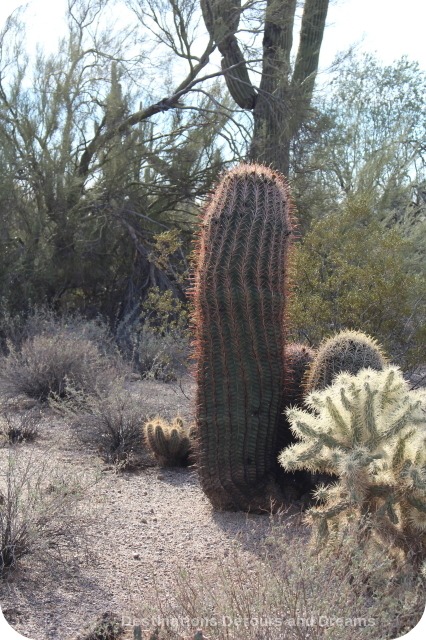
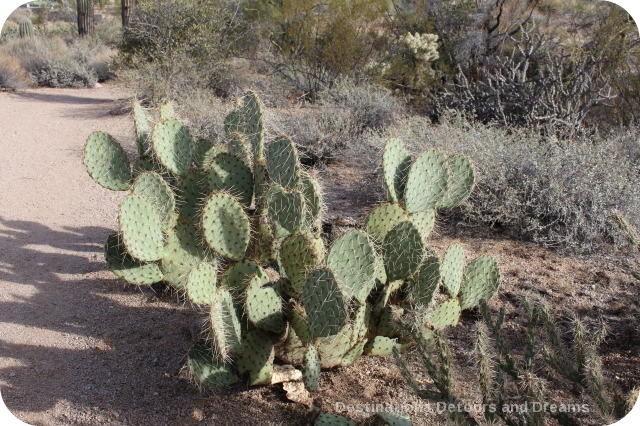
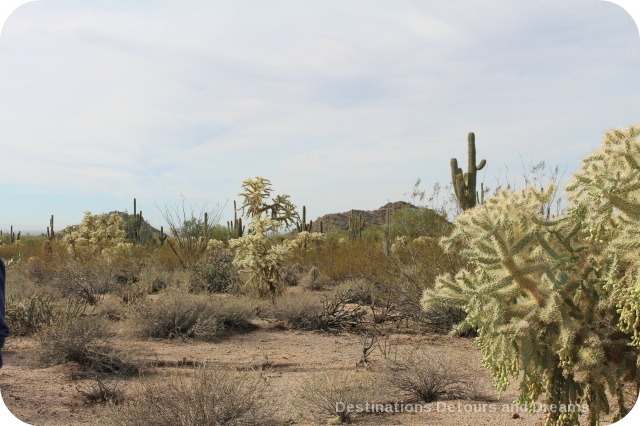
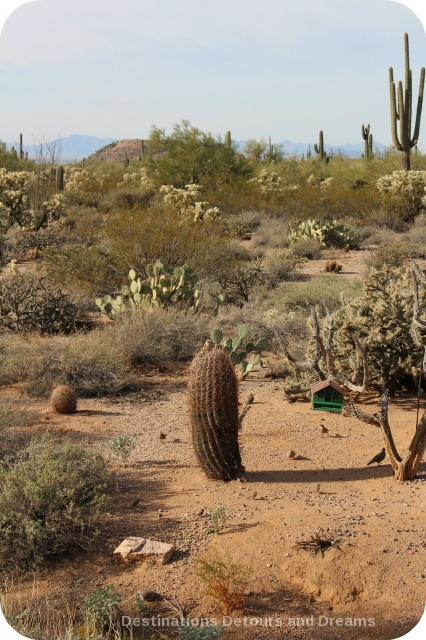
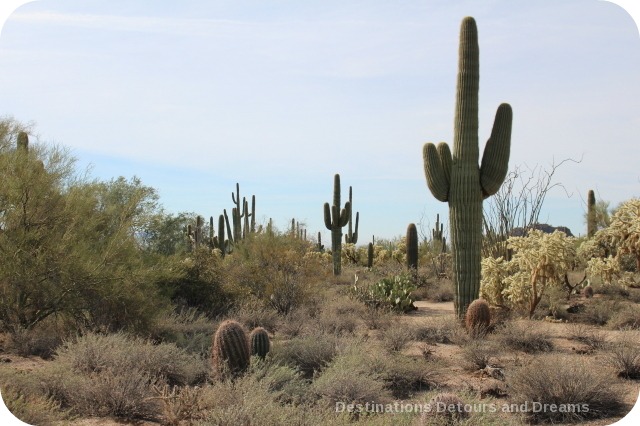
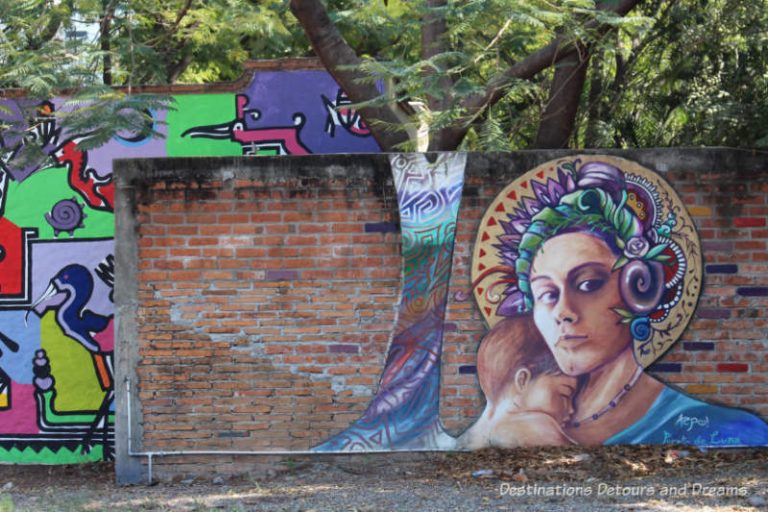
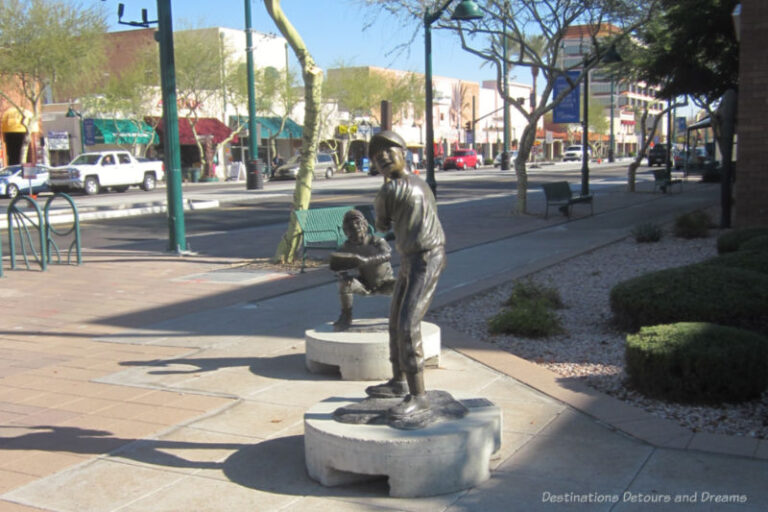
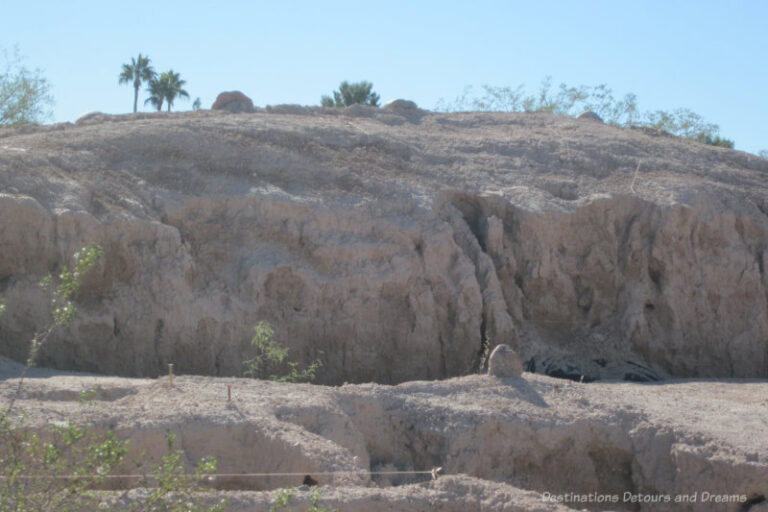
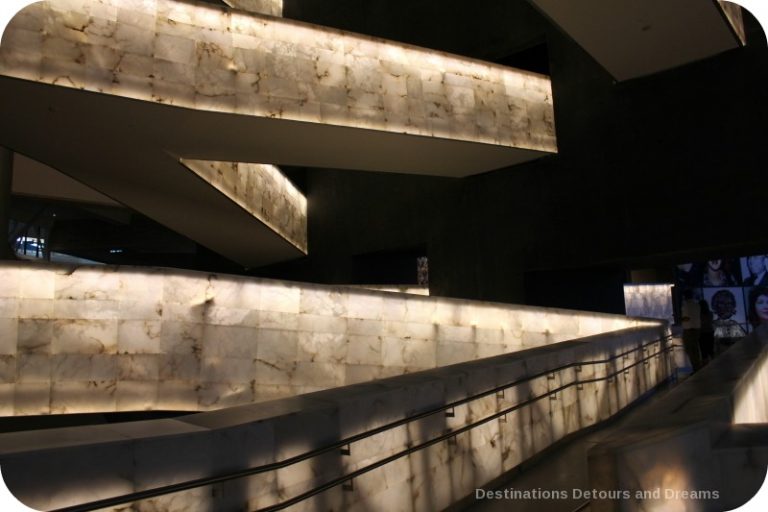

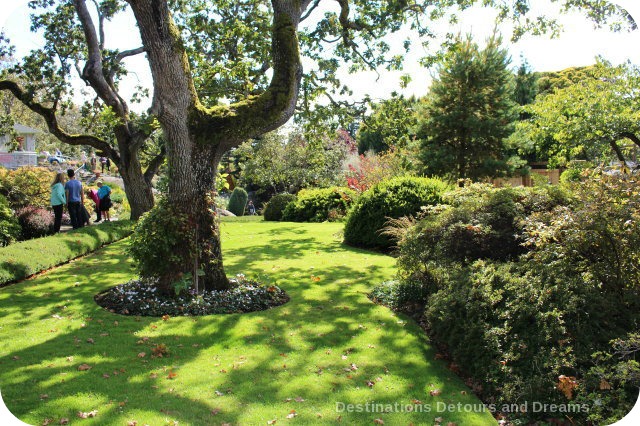
I’ve not heard of this park, but then my time in Phoenix has been limited. I find the history of all this foliage that is able to survive in dry conditions, I have to admit that I’ve never found it appealing! Laugh! I think I am more of tropical foliage person…I tend to be drawn to colors!
Jacquie, the Sonoran desert landscape doesn’t appeal to everyone, but I find it fascinating, especially the survival and adaptation techniques. I’ve never appreciated before how many shades of green there are. I can understand the appeal of the colours of tropical foliage. The Sonoran desert can be quite colourful in spring, first with wild flowers, later with the vibrant colours of cacti blooms, but it can also be pretty drab in mid-winter.
Donna, this was fascinating. I liked the part about the cacti and the myths that were broken – I had heard similar stories but what really fascinated me was the chainfruit cholla and the palo verde tree. I had never heard of either one and somehow you don’t really think about trees of any kind growing in the desert. The way they’ve adapted to their environment is pretty amazing too – drought-deciduous and thin leaves. Thanks for sharing this, really enjoyed it.
Thanks Lenie. It is quite amazing how the plants have adapted.
My husband and I took this same tour years ago Donna. The one thing I remember is how little time you can suffer from dehydration – you need a bottle of water every hour or two. Everything is relative to your size and weight. Still not much time!
Pat, I don’t remember dehydration times coming up on the tour, but it might have. Although the guide had some specific things he made a point of covering, a lot of what was talked about was generated by questions from the group, which suggests you might learn something a little different each time you took the walk. (Although I suspect the same common questions get asked over and over again.)
I hadn’t heard of the park although I live within a couple hours of it. Definitely, it’s on my list of places to visit, which usually happens when we have family visiting. We get javalina in our yard quite often and they drive us crazy. I know. They were here first. But they destroy many of our cacti or at least uproot them and eat only a little bit. We finally caved to them after they tore up our little patch of grass one too many times. We have a little patch of artificial turf now. Thanks for telling about this tour.
Beth, I’ve been visiting this area for many years and it is only in the last year I visited this park. They have a lot of guided tours and sessions covering different topics. Plus good hiking trails and a nice playground for young children. I was so thrilled last winter to see my first javelina, but it sounds as if you’d be quite happy never to see another one.
Terrific images as always Donna. I am glad you cleared up that myth about cactus and water, not that I ever want to find myself in need of trying to get water from a cactus! This sounds like it was a great tour, thanks so much for sharing with us!
Thanks Marquita. I hope you’ve never in a situation where you have to choose between dying of thirst and acidic cactus water.
Love these pictures. I must say that I often just take plants for granted and don’t think much of them. But when I stop to think about how they adapt and survive, it is really fascinating. There is a tree down the block from me that is being blocked from the sun by a larger tree. To survive, it grew horizontal until it got to the point where it could escape the shade from the other tree and then started to grow vertically. So amazing. I’ve spent very little time in the dessert, so I think I would really enjoy the tour at Usery Mountain Park.
Erica, it is amazing what plants do to survive. It must have been interesting to watch that tree grow horizontally until it could get into the sunlight.
It looks so warm at Usery Mountain Park in comparison to the cold in the UK! I would visit just for the sun alone!
Seriously, how interesting that you can eat fruit from all cacti. I am guessing that when the fruit is bitter, it is bitter!
A little frightening that the water in cacti can be deadly to humans. If one were stranded they would need to decide whether to die of thirst or from the acidic cacti waters.
Phoenicia, I suspect many cacti fruit are quite bitter. Prickly pear fruit are used a lot in syrups, jams, and candy, which are tasty enough, but sugar is added. I hope you’re never stranded in a place where you need to choose dying from thirst or acidic cacti can water.
Haven’t heard of the park either. Great pictures and so interesting how dissimilar deserts in different parts of the world look. No comparison to the empty quarter on the Arabian peninsula.
Catarina, it is interesting how deserts can look different from each other. I certainly had a different vision of desert in my head when I first saw the Sonoran desert and was quite surprised by it.
I am drawn to desert landscapes, but am by no means a plant expert. I’ve been all over the southwest to various national parks. I think it was Edward Abbey who wrote about how the life in the desert exists in such a precarious balance. That’s why I love it so much. Everything subsists on very little. I can respect that.
Jeri, I think it is that precarious balance (and the subdued beauty in unexpected places) that draws me to the southwest desert.
I haven’t been to that park but have always found deserts to be fascinatingly beautiful. Each plant is so unique. They have a sort of standalone quality as opposed to the collective character of forest plants.
Ken, I hadn’t really thought about the desert plants in terms of standalone quality, but you’re right. They do have that.
I always love hearing about nature tours and ranger talks, Donna. I’ve hiked in the Saguaro National Park, but not this one. that was a December hike. The desert is fascinating for someone who grew up in the humid east. Love the pics.
Thanks Rose Mary. We also did this walk in early December.
What a great informational post.
I know when I took survival training we were taught about not drinking from cactus. You would not imagine how many soldiers, argued that you could.
I am glad, I never ended up in the desert alone with them. Of course if I did, and they drank from the cactus, I would have someone, mean something to eat.
Thanks for sharing.
Thanks William. It is a good thing you never ended up stranded in the desert with these guys, or wth or without anyone else for that matter.
I haven’t heard of this park either. But it is interesting. Deserts can really be beautiful. Cacti look like works of art.
Thanks Susan. So much of nature is a work of art, isn’t it?
For better or for worse, when I think of deserts, I think of rattlesnakes. Were you ever warned about rattlesnakes during your visit? That said, Usery Mountain Regional Park sounds like my kind of vacation destination. Hiking around in the desert – what could be cooler than that? Way better than wandering around in a museum, eh?
Andy, some parks and gardens have signs warning of rattlesnakes if you go off the path. I’ve not encountered a rattlesnake, but I stay on the paths.
Really interesting post. I lived in the Australian desert for 4 years and was completely amazed by the quantity and variety of plant material. Seeing this desert park reminds me of that area, though this is far more planty! Interesting to hear about how plants adapt to their environment to make the most of the basic life support elements, water, photosynthesis, reproduction.
It’s definitely on my list of international gardens to visit, thanks for the post Donna
I too was surprised at the quantity and variety of plant material in the desert. Nature’s ability to adapt, survive, and thrive is amazing.
Though our time in Phoenix area was limited on our recent road trip we really enjoyed nature there and in Arizona! Loved the cacti, incredible there are so many variations and colours, right?!
I was surprised by the variations of colour (so many shades of green) when I first visited the Sonoran Desert. It continues to delight each time I go back.